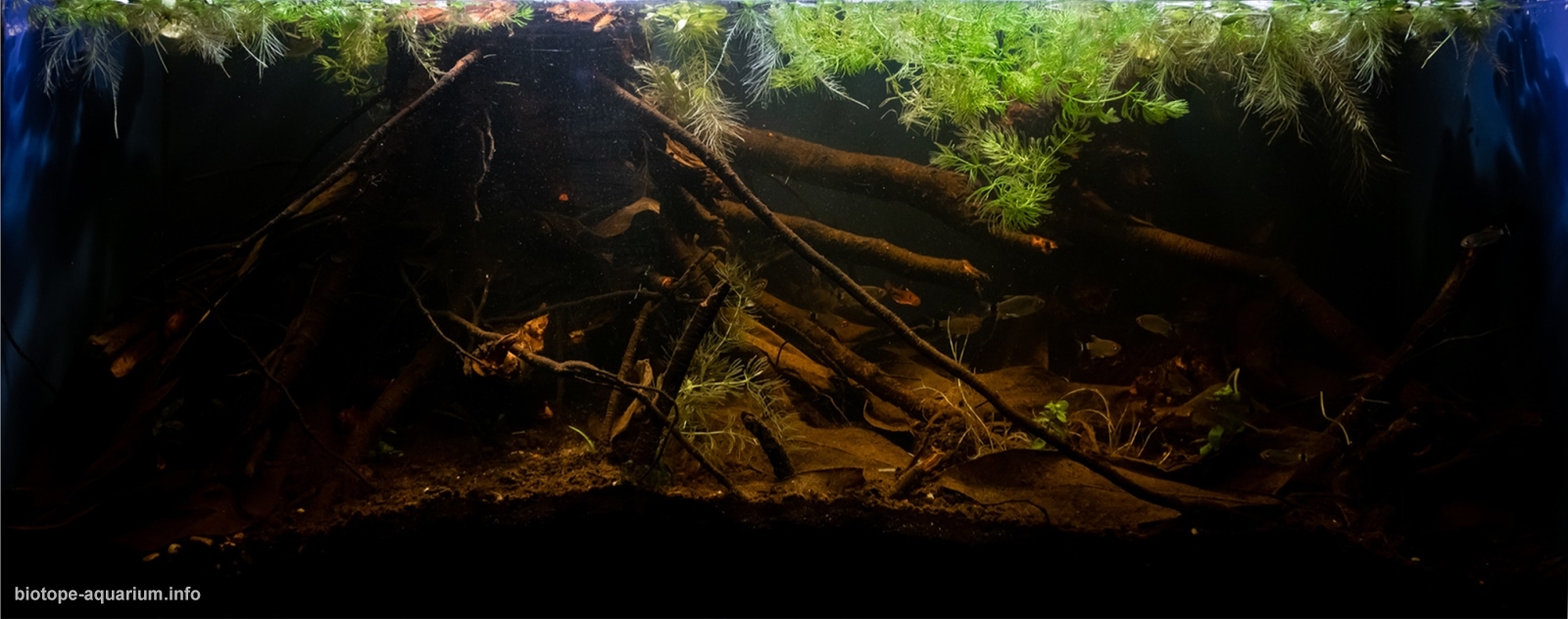Salobra River in the southern Pantanal wetlands of Mato Grosso do Sul, Brazil
_th place in Biotope Aquarium Design Contest 2020

Volume: 180 L
Dimensions: 100х40х45 cm
List of fishes: Moenkhausia sanctaefilomenae , Hyphessobrycon eques, Corydoras paleatus, Ancistrus Dolichopterus
List of plants: Pistia, Ceratophyllum demérsum, Bacopa caroliniana, Carex riparia (submerged surface plant)
Description of decorations: to create a more accurate copy of the selected biotope, I used untreated tree roots . River sand and river pebbles were used as the soil in the lower layers. the main elements of the soil are peat-swamp soil and ferrallite soils (dark red). Surface herbaceous plants were planted in advance in an aquarium with a minimum water level
Description of equipment: AQUAEL Unifilter 1000 UV Filter, AQUAEL Platinium Heater 300w, AQUAEL OXYBOOST 150 plus Compressor, 5 10W led floodlights(6500K).
Water parameters:
ph 7,
the temperature of 23-25°C
GH3
KH1
the water, despite its dark color, is transparent
Additional info: water change once a week for at least 25 %
INFORMATION ABOUT BIOTOPE:
Description of the area surrounding the biotope: The name Pantanal comes from the Portuguese word pântano – swampy lowland, wet lowland. This natural region covers an area of over 135 thousand square kilometers, 65% of which is located in the state of Mato Grosso do Sul. The climate of the Pantanal is tropical, with a pronounced dry period from may to September, and a rainy season that begins from November to April. As a result, the water level of the Pantanal rises to 5 meters, forming a region filled with numerous lakes and rivers. One of these rivers is the Salobra.
Description of the underwater landscape of the biotope: During the flood season, when the river banks and surrounding meadows and forests are submerged, the landscape is formed from submerged surface plants, roots of bushes and trees growing along the riverbed. But still, the main elements are a dense litter of dense layers of rotting leaves. Decomposing material provides habitat and food for many species of small fish, which in turn provide food for larger species, and so on down the food chain.
The water in the river, despite its dark color, is transparent. Podzolic soils and a high content of tannins and humic substances give the water a dark color. These substances are synthesized in plants (mainly in the bark and leaves) and after their death fall into the water.
Description of the parameters of the habitat: The water in the river, despite its dark color, is transparent. The temperature varies from 22.4°C to 34.5°C throughout the year, and the ph can vary from 7 to 8.4
List of fishes and invertebrates occurring in the nature biotope: Paracheirodon axelrodi, Moenkhausia sanctaefilomenae , Hyphessobrycon minor, Corydoras paleatus, Ancistrus Dolichopterus, Corydoras hastatus,
Aphyocharax dentatus, Aphyocharax nattereri, Aphyocharax rathbuni, Characidium laterale, Corydoras hastatus, Crenicichla lepidota, Hemigrammus neptunus, Hemigrammus tridens, Hemigrammus ulreyi, Moenkhausia bonita, Psellogrammus kennedyii, Serrapinnus calliurus and Serrapinnus kriegi.
List of plants found in the nature biotope: Pistia, Ceratophyllum demérsum, and submerged surface plants are present in the biotope site I described.
Threats to the ecology: the Salobra River is the only river in the state where fishing is prohibited, which means that the fishing community is large and diverse, which in turn supports many other animals here, including a large number of birds, giant otters, and countless other creatures.
Since 2000, the Pantanal has been a UNESCO world natural heritage site.
Sources of information:
https://www.instagram.com/
https://www.
https://ru.wikipedia.org/
https://bigenc.ru/
http://ecosystema.ru/
https://www.youtube.com/watch?
